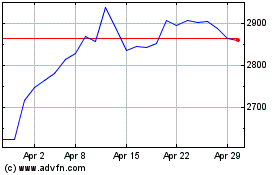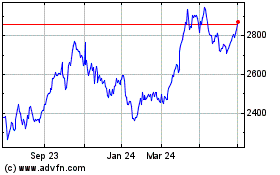Brent Oil Set to Disappear as Crude-Price Benchmark Lives On
December 02 2019 - 6:36AM
Dow Jones News
By Sarah McFarlane
The world's most famous oil and gas field -- and the backbone of
global crude pricing -- has dried up. Soon the Brent benchmark will
have no Brent oil.
Royal Dutch Shell PLC is expected next year to plug the last
remaining Brent oil wells, located in the North Sea's East Shetland
Basin, about 115 miles northeast of Scotland's Shetland Islands.
The closures mark the end of an era, as the industry shifts its
focus to smaller oil finds near existing infrastructure.
Many companies are shutting down platforms above massive fields
discovered in the 1970s, but Brent stands apart as one of the first
and most significant of these finds. The field has generated
billions of dollars for Shell, its partner in the field, Exxon
Mobil Corp. and the U.K. government.
In the late 1980s, Brent crude became the benchmark on which
most of the world's oil is priced and is still used to set the
price of the multi-trillion dollar Intercontinental Exchange Brent
futures market.
"The role it has played is a cornerstone for this industry now
for 40 plus years," said Steve Phimister, vice president of
upstream and director of U.K. operations at Shell.
The Brent benchmark will keep its name and increasingly
represents a blend of North Sea crudes, with the potential to
include oil from other locations in the future.
Shell discovered the field in 1971 and named it after the brent
goose, keeping with the seabird theme the company used for naming
its discoveries at the time. Developing it was a huge and expensive
undertaking. Standing as tall as the Eiffel tower, Brent Charlie,
the last active platform of Brent's original four, was built to
withstand some of the most hostile conditions on earth.
The North Sea's wave heights of up to 12 meters and gale-force
winds of up to 100 miles an hour make it a place for "hardy
individuals," said Aberdeen-based Alan Lawrie, who joined Shell in
1984 when he was 16 years old. Now 51 and manager of Shell's
Charlie platform, he said Brent was the field everyone vied to work
on.
Like all of the approximately 180 workers on the platform, Mr.
Lawrie is on a fly-in fly-out rotation, spending two weeks offshore
at a time and working 12-hour shifts while there. The Charlie
platform can house up to 192 people in what is like a miniature
village on an island in the middle of nowhere. It has restaurants,
games rooms and a gym -- where Mr. Lawrie has spent much of his
downtime on a rowing machine.
One of his fondest memories is celebrating his 21st birthday on
Charlie with his colleagues, who teased him with a gift of an
18-inch model wooden oar that one of them had whittled between
shifts on the platform.
The North Sea oil rush was helped by higher oil prices after the
Arab Oil Embargo in the early 1970s, when crude prices quadrupled.
Oil got another jolt from shortages caused by the Iranian
Revolution in 1979.
"We were importing all our oil and the main emphasis from the
U.K. government, and oil companies was to get to first oil as
quickly as possible, to help our balance of payments, which was
suffering badly because of a huge bill for paying for oil imports,"
says Alex Kemp, professor of petroleum economics at the University
of Aberdeen Business School.
The project was risky and had massive cost overruns, as the
North Sea was a frontier region, and the effort used new
technologies to go deeper underwater than ever before and drill
more than 4 miles beneath the seabed.
North Sea oil production has been in decline since the turn of
the century, partly because it was too expensive to compete with
other regions. At its peak in 1982 Brent produced more than 500,000
barrels a day, enough to meet the annual energy needs of around
half of all U.K. homes at the time. The U.K. region of the North
Sea produced around 1.8 million barrels a day of oil and gas last
year, less than half the peak hit in 1999.
As Brent production declined, several other oil grades were
added to what is now a basket of North Sea crudes used to set the
Brent price. Still, production of the grades used to price Brent is
expected to drop by half -- to 500,000 barrels a day -- by 2025
because of a lack of investment and fields winding down.
The Brent benchmark's main competitor, U.S. West Texas
Intermediate, is backed by much higher volumes of crude. Around 4
million barrels a day of U.S. crude, which represents around 4% of
global production, meets the quality requirements needed for
delivery against WTI futures.
Some researchers, including the Oxford Institute for Energy
Studies, believe that the Brent benchmark could eventually include
U.S. crude to set the price.
Meanwhile, Shell is set to decommission the Charlie platform
sometime next year. "There's a tear in your eye when we're removing
the big ones, " says Shell's Mr. Lawrie, referring to the
platforms. "But it's a natural part of the life-cycle of the
industry we work in."
Write to Sarah McFarlane at sarah.mcfarlane@wsj.com
(END) Dow Jones Newswires
December 02, 2019 06:21 ET (11:21 GMT)
Copyright (c) 2019 Dow Jones & Company, Inc.
Shell (LSE:SHEL)
Historical Stock Chart
From Mar 2024 to Apr 2024

Shell (LSE:SHEL)
Historical Stock Chart
From Apr 2023 to Apr 2024
